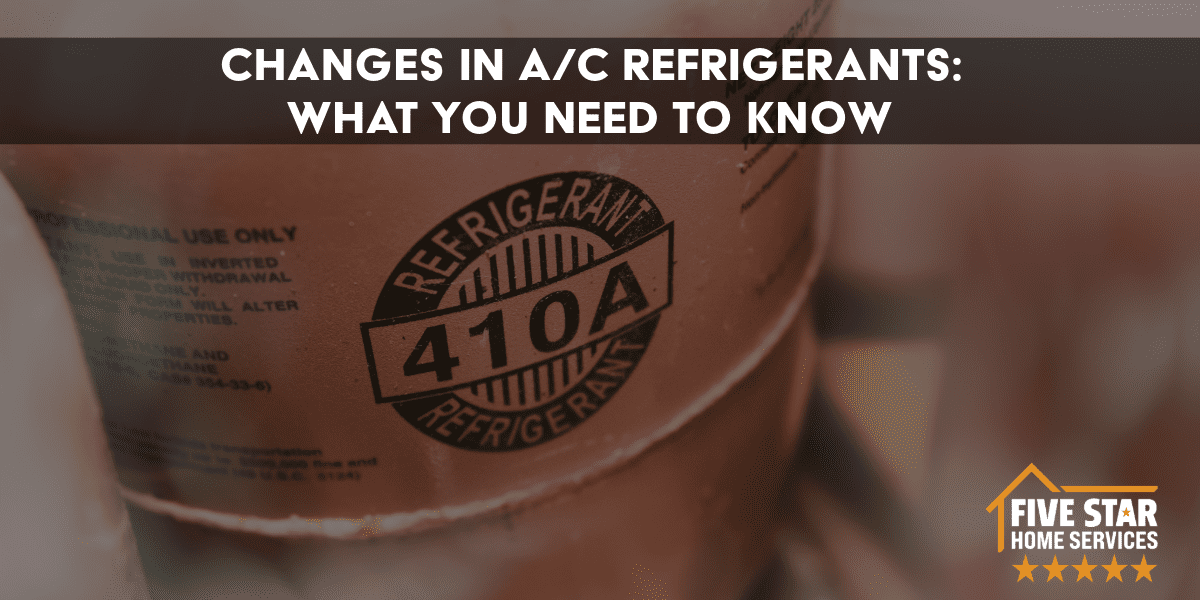Refrigerants are the lifeblood of home cooling systems and heat pumps. However, what are refrigerants, and what does this mean for the average homeowner? We’ll delve into this topic more in the following.
While most homeowners might not give much thought to AC refrigerants and the different types available, we at Five Star Home Services want our customers to be as informed as possible. The following article covers what refrigerant is, the different types of AC refrigerants, and what to do about old and new refrigerants.
What Is a Refrigerant?
A refrigerant is a substance or mixture, often a fluid, used in a heat pump and refrigeration cycle to extract heat from one area and disperse it into another. Most commonly used in air conditioning systems, refrigerators, and freezers, refrigerants operate by changing phase from gas to liquid and back again, absorbing and releasing heat.
While there are many different types of refrigerants, they can largely be categorized into three primary types: chlorofluorocarbons (CFCs), hydrochlorofluorocarbons (HCFCs), and hydrofluorocarbons (HFCs). Each type has its properties, benefits, and environmental impacts. For instance, while CFCs were widely used in the 20th century, their production has been phased out due to their destructive effect on the Earth’s ozone layer. On the other hand, HFCs, which do not deplete the ozone, are now becoming more prevalent. Yet, they, too, have come under scrutiny for their potential contribution to global warming.
What Types of Refrigerants Are There?
Refrigerants come in a variety of types, each suited to different applications. The most common include:
Chlorofluorocarbons (CFCs): These were commonly used in the 20th century but are now largely phased out due to their detrimental impact on the ozone layer.
Hydrochlorofluorocarbons (HCFCs): These are less harmful than CFCs, but still pose some environmental risks and are also being phased out.
Hydrofluorocarbons (HFCs): HFCs are more environmentally friendly than both CFCs and HCFCs and are widely used today.
Natural Refrigerants include carbon dioxide, ammonia and hydrocarbons such as propane and iso-butane. They have minimal environmental impact but can be more challenging to use effectively.
Every type of refrigerant has different properties related to efficiency, environmental impact, and safety. Your choice of refrigerant should depend on the cooling system’s specific requirements.
Years ago, the earliest refrigerants were made of toxic or flammable gasses such as ammonia, methyl chloride, and even propane. In 1928, non-flammable, non-toxic Freon was developed to replace earlier refrigerants using CFCs or chlorofluorocarbons. Then, in the 1980s it was discovered these types of refrigerants were devastatingly affecting the environment. Because of this discovery, new refrigerants were developed that are now heavily regulated by the federal government.
By 1987, all CFCs were banned and no longer produced. A common CFC refrigerant used during this period was Freon or R-12. While all the CFC’s was being phased out a new class of refrigerants called hydrochlorofluorocarbon or HCFC replaced CFCs. Commonly used as a refrigerant and a propellant, these were seen as a better alternative to the ozone-depleting Freon. Additionally, R22 was a common refrigerant being used and is still found in many older air conditioners today. In 2010, HCFC class refrigerants were banned and no longer being produced, though they can still be used inside systems installed before 2010.
More recently, R-410a has become the preferred refrigerant in the HVAC industry. This is largely because it is even more environmentally conscious. Most air conditioning systems and heat pumps across the United States use R-410a.
What Should I Do if I Have R-22?
If your HVAC system still uses R22, no worries! You don’t need to replace or stop using it right away. In fact, the EPA plans to slowly phase out these harmful chemicals over another eight years. This way, homeowners can switch to far more environmentally friendly refrigerants, which are much more convenient for their system.
If your central air conditioner or heat pump was installed before 2010, there’s a good chance that you have R-22. Because it is hard on the ozone, this is a banned refrigerant. This means that R22 is becoming increasingly hard to get. Since it is no longer being produced, all the R-22 in stock is recycled and is becoming increasingly more expensive as the remaining supply is depleted. By 2040 the supply is expected to be gone. It will be nearly impossible to find.
If you have a system with R-22, we recommend being proactive. Take maintenance steps to avoid refrigerant leaks in your system. Regular scheduled maintenance and tune-ups can help you get a little more life out of the system. Nevertheless, keep in mind that as soon as a leak occurs, or if the unit needs repaired, it might be more cost effective to replace the unit altogether.
New Refrigerants on the Horizon?
If we’ve seen one constant thing over the past 50 years, it’s that the HVAC industry is constantly changing! Change is the only real thing! With new technology being developed each and every year. The same is true for the development of new refrigerants as well. Keep in mind, the perfect refrigerant has yet to be discovered. In fact, the goal of developing an effective refrigerant that won’t harm the environment is still being developed. The latest refrigerant is the R-454b. This is a non-toxic, mildly
flammable ac refrigerant that has zero effect on the ozone and carries a much lower risk for global warming.
Several manufacturers have already selected this refrigerant. Additionally, new equipment with R-454b have already started entering the market. Mitsubishi Electric, Carrier, Johnson Controls, and others have already decided on making the change. However, as time goes on and with R-410a scheduled for elimination in 2023, others are joining that list. In any case, there’s no need to worry though. There will be plenty of R-410a for any repairs for many years to come.
What Steps to Take From Here?
Although HVAC regulations are likely to shift over time, it is important to have a basic understanding of how these changes will affect you. If you’d like to learn more about AC refrigerants or want to discuss heating and air conditioning solutions for your home, give us a call.
At Five Star Home Services, we are proud to be your local home cooling company throughout Central Ohio and Southwest Ohio!
We make keeping you cool as easy as a breeze!


